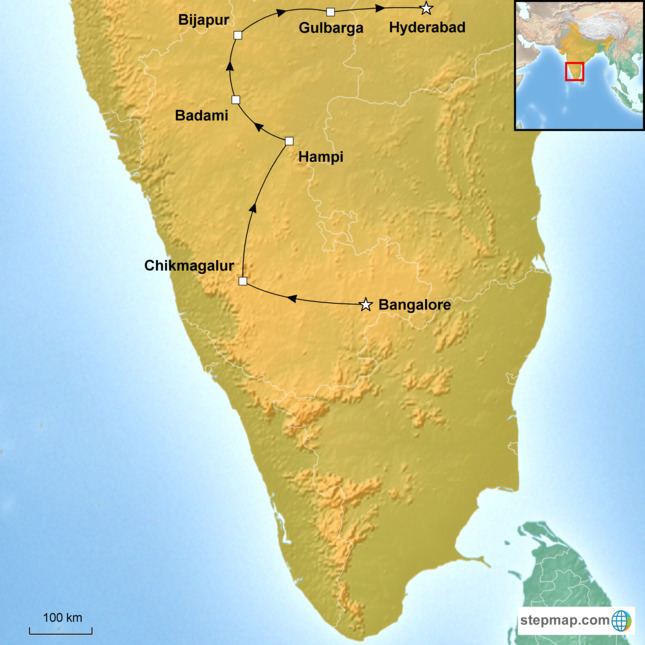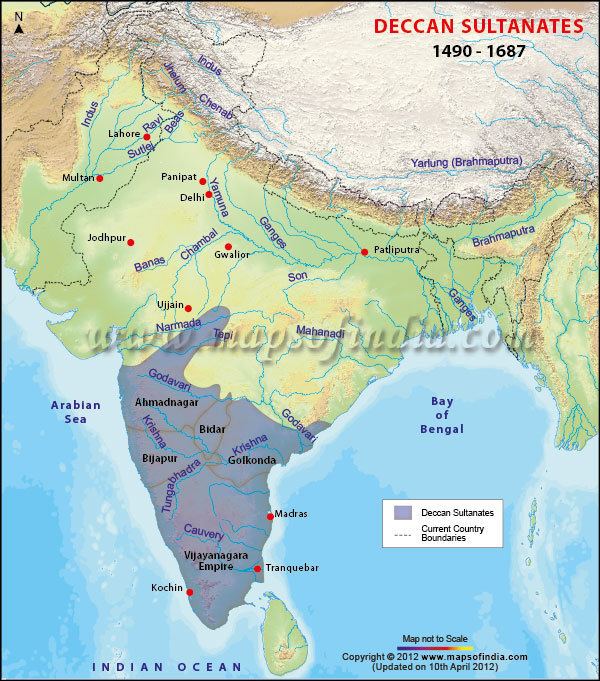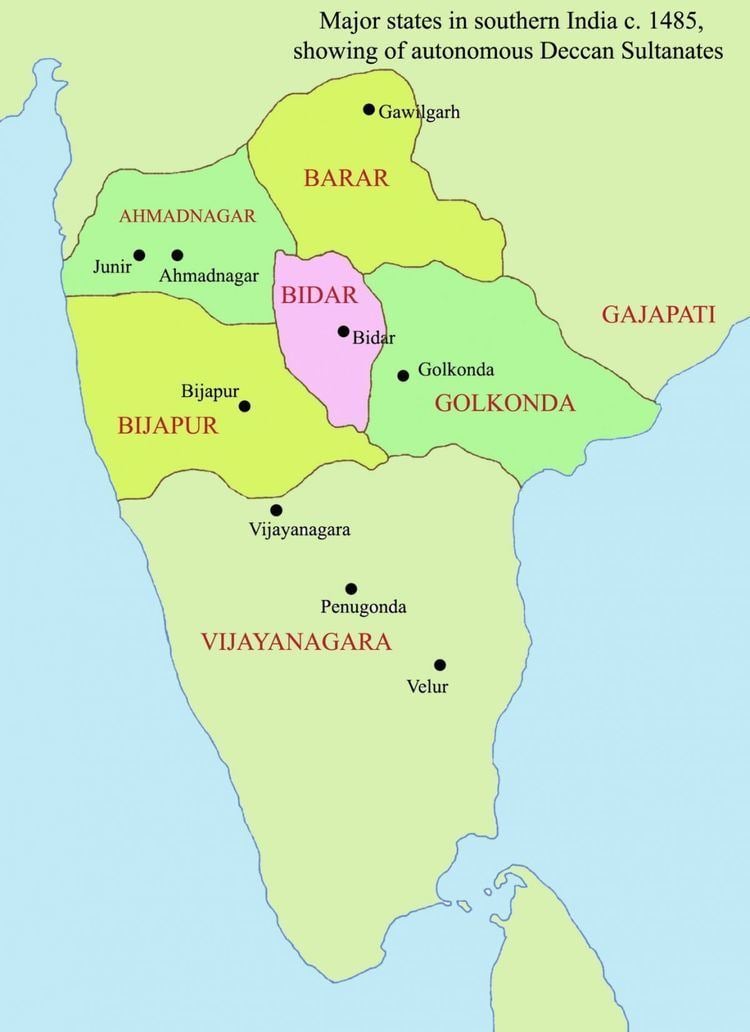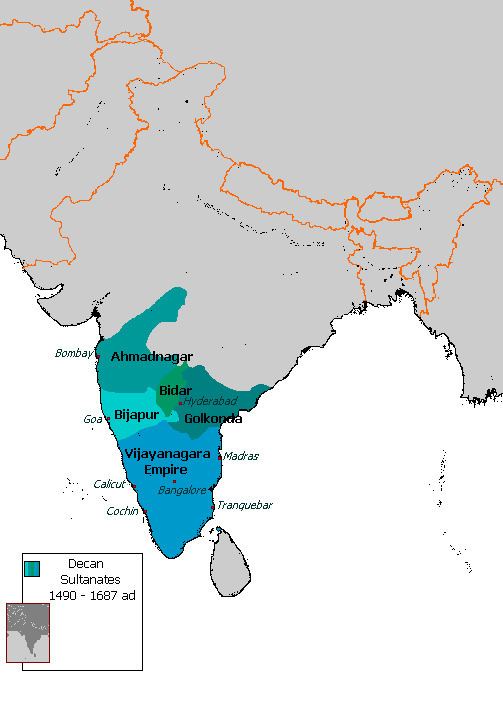Languages Dakhini Government Monarchy Established 1527 Founded 1490 | Historical era Late Medieval Disestablished 1686 Date dissolved 1686 | |
 | ||
Capitals | ||
The Deccan sultanates were five Dynasties of various ethnic backgrounds (Afghan, Turk, Mongol etc.) that ruled late medieval kingdoms, namely, Bijapur, Golkonda, Ahmadnagar, Bidar, and Berar in south-western India. The Deccan sultanates were located on the Deccan Plateau, between the Krishna River and the Vindhya Range. These kingdoms became independent during the break-up of the Bahmani Sultanate. In 1490, Ahmadnagar declared independence, followed by Bijapur and Berar in the same year. Golkonda became independent in 1518 and Bidar in 1528. In 1510, Bijapur repulsed an invasion by the Portuguese against the city of Goa, but lost it later that year.
Contents
- Deccan Sultanates Post Bahamani Era History of Golconda Bijapur Bidar Ahmednagar and Berar
- Ahmadnagar sultanate
- Rulers
- Berar sultanate
- Bidar sultanate
- Bijapur sultanate
- Golkonda Sultanate
- Cultural contributions
- Golkonda sultanate
- References

Although generally rivals, they did ally against the Vijayanagara Empire in 1565, permanently weakening Vijayanagar in the Battle of Talikota. In 1574, after a coup in Berar, Ahmadnagar invaded and conquered it. In 1619, Bidar was annexed by Bijapur. The sultanates were later conquered by the Mughal Empire; Berar was stripped from Ahmadnagar in 1596, Ahmadnagar was completely taken between 1616 and 1636, and Golkonda and Bijapur conquered by Aurangzeb's 1686-87 campaign.

Deccan Sultanates - Post - Bahamani Era || History of Golconda, Bijapur, Bidar, Ahmednagar and Berar
Ahmadnagar sultanate

Malik Ahmad Shah Bahri, the governor of Junnar after defeating the Bahmani army led by general Jahangir Khan on May 28, 1490 declared independence and established the Nizam Shahi dynasty rule over the sultanate of Ahmadnagar. The territory of the sultanate was located in the northwestern Deccan, between the sultanates of Gujarat and Bijapur. Initially his capital was in Junnar. In 1494, the foundation was laid for the new capital Ahmadnagar. Malik Ahmed Shah after several attempts, secured the great fortress of Daulatabad in 1499. After his death in 1510, his son Burhan, a boy of seven was installed in his place. Burhan Shah I died in Ahmadnagar in 1553. He left six sons, of whom Hussain succeeded him. After the death of Hussain Shah I in 1565, his minor son Murtaza ascended the throne. During his minority, his mother Khanzada Humayun Sultana ruled as a regent for several years. Murtaza Shah annexed Berar in 1574. On his death in 1588, his son Miran Hussain ascended the throne. But his reign could last only a little more than ten months as he was poisoned to death. Ismail, a cousin of Miran Hussain was raised to the throne, but the actual power was in the hands of Jamal Khan, the leader of the Deccani group in the court. Jamal Khan was killed in the battle of Rohankhed in 1591 and soon Ismail Shah was also captured and confined by his father Burhan, who ascended the throne as Burhan Shah. After the death of Burhan Shah his eldest son Ibrahim ascended the throne. Ibrahim Shah died only after a few months in the battle with Bijapur sultanate. Soon, Chand Bibi, the aunt of Ibrahim Shah, proclaimed Bahadur, the infant son Ibrahim Shah as the rightful Sultan and she became the regent of him. In 1596, Mughal attack led by Murad was repulsed bravely by Chand Bibi. After the death of Chand Bibi in July,1600 Ahmadnagar was conquered by the Mughals and Bahadur Shah was imprisoned. But Malik Ambar and other Ahmadnagar officials defied the Mughals and declared Murtaza Shah II as sultan in 1600 at a new capital Paranda. Malik Ambar became prime minister and Vakil-us-Saltanat of Ahmadnagar. Later, the capital was shifted first to Junnar and then to a new city Khadki (later Aurangabad). After the death of Malik Ambar, his son Fath Khan surrendered to the Mughals in 1633 and handed over the young Nizam Shahi ruler Hussain Shah, who was sent as a prisoner to the fort of Gwalior. But soon, Shahaji with the assistance of Bijapur, placed an infant scion of the Nizam Shahi dynasty, Murtaza on the throne and he became the regent. In 1636 Aurangzeb, then Mughal viceroy of Deccan finally annexed the sultanate to the Mughal Empire after defeating Shahaji.
Rulers

- Malik Ahmad Nizam Shah I 1490–1510
- Burhan Nizam Shah I 1510–1553
- Hussain Nizam Shah I 1553–1565
- Murtaza Nizam Shah 1565–1588
- Miran Nizam Hussain 1588–1589
- Isma'il Nizam Shah 1589–1591
- Burhan Nizam Shah II 1591–1595
- Ibrahim Nizam Shah 1595–1596
- Ahmad Nizam Shah II 1596
- Bahadur Nizam Shah 1596–1600
- Murtaza Nizam Shah II 1600–1610
- Burhan Nizam Shah III 1610–1631
- Hussain Nizam Shah II 1631–1633
- Murtaza Nizam Shah III 1633–1636.

Berar sultanate

During the disintegration of Bahmani Sultanate, Fathullah Imad-ul-Mulk, governor of Berar declared independence in 1490 and founded the Imad Shahi dynasty of Berar Sultanate. He established the capital at Achalpur (Ellichpur). Gavilgad and Narnala were also fortified by him. He was succeeded by his eldest son Ala-ud-din after his death in 1504. In 1528, Ala-ud-din resisted the aggression of Ahmadnagar with the help from Bahadur Shah, sultan of Gujarat. The next ruler, Darya first tried to align with Bijapur to prevent aggression of Ahmadnagar, but was unsuccessful. Later, he helped Ahmednagar on three occasions against Bijapur. After his death in 1562, his infant son Burhan succeeded him to the throne. But in 1574, Tufal Khan, a minister of Burhan usurped Burhan Imad Shah, the last ruler of Imad Shahi dynasty and in the same year Murtaza I, sultan of Ahmadnagar annexed it to his sultanate. Burhan, along with Tufal Khan and his son Shamshir-ul-Mulk were taken to Ahmadnagar and confined to a fortress where all of them subsequently died.
Rulers
- Fathullah Imad-ul-Mulk 1490–1504
- Ala-ud-din Imad Shah 1504–1530
- Darya Imad Shah 1530–1562
- Burhan Imad Shah 1562–1574
- Tufal Khan (usurper) 1574.
Bidar sultanate
Bidar was the smallest of the five Deccan sultanates. Qasim Barid, founder of the Barid Shahi dynasty joined the service of Bahmani ruler Mahmud Shah Bahmani (r.1482–1518) as a sar-naubat but later became mir-jumla of the Bahmani sultanate. In 1492, he became de facto ruler of Bahmani sultanate, though Sultan Mahmud Shah Bahmani remained as the formal ruler. After his death in 1504, his son Amir Barid controlled the administration of the Bahmani sultanate. In 1528, with the flight of the last Bahmani ruler Kalimullah from Bidar, Amir Barid became practically independent. Amir Barid was succeeded by his son Ali Barid, who was the first to assume the title of Shah. He participated in the Battle of Talikota. He was fond of poetry and calligraphy. The last ruler of the Bidar sulatante Amir Barid Shah III was defeated in 1619, and the sultanate was annexed to Bijapur Sultanate.
Rulers
- Qasim Barid I 1492–1504
- Amir Barid I 1504–1542
- Ali Barid Shah 1542–1580
- Ibrahim Barid Shah 1580–1587
- Qasim Barid Shah II 1587–1591
- Ali Barid Shah II 1591
- Amir Barid Shah II 1591–1600
- Mirza Ali Barid Shah III 1600–1609
- Amir Barid Shah III 1609–1619.
Bijapur sultanate
The Bijapur sultanate was ruled by the Adil Shahi dynasty from 1490 to 1686. The Adil Shahis were originally provincial rulers of the Bahmani Sultanate, but with the break-up of the Bahmani state after 1518, Ismail Adil Shah established an independent sultanate, one of the five Deccan sultanates.
The Bijapur sultanate was located in southwestern India, straddling the Western Ghats range of southern Maharashtra and northern Karnataka. Ismail Adil Shah and his successors embellished the capital at Bijapur with numerous monuments.
The Adil Shahis fought the empire of Vijayanagar, which lay to the south across the Tungabhadra River, and fought the other sultanates as well. The sultanates combined forces to deliver a decisive defeat to Vijayanagar in 1565, after which the empire broke up. Bijapur seized control of the Raichur Doab from Vijayanagar. In 1619, the Adil Shahis conquered the neighbouring sultanate of Bidar, which was incorporated into their realm. In the 17th century, the Marathas revolted successfully under Shivaji's leadership and captured major parts of the Sultanate like Bijapur. The weakened Sultanate was conquered by Aurangzeb in 1686 with the fall of Bijapur, bringing the dynasty to an end.
Rulers
- Yusuf Adil Shah 1490–1510
- Ismail Adil Shah 1510–1534
- Mallu Adil Shah 1534–1535
- Ibrahim Adil Shah I 1535–1558
- Ali Adil Shah I 1558–1580
- Ibrahim Adil Shah II 1580–1627
- Mohammed Adil Shah 1627–1656
- Ali Adil Shah II 1656–1672
- Sikandar Adil Shah 1672–1686.
Golkonda Sultanate
The dynasty's founder, Sultan Quli Qutub-ul-Mulk, migrated to Delhi with some of his relatives and friends in the beginning of the 16th century. Later he migrated south to Deccan and served Bahmani sultan Mohammad Shah. He conquered Golkonda and became the Governor of Telangana region in 1518, after the disintegration of the Bahmani sultanate into the five Deccan sultanates. Soon after, he declared independence from the Bahmani sultanate, took title Qutb Shah, and established Qutb Shahi dynasty of Golconda. The dynasty ruled for 171 years, until the Mughal emperor Aurangzeb's army conquered Golkonda in 1687.
Rulers
- Sultan Quli Qutb-ul-Mulk 1518–1543
- Jamsheed Quli Qutb Shah 1543–1550
- Subhan Quli Qutb Shah 1550
- Ibrahim Quli Qutub Shah 1550–1580
- Muhammad Quli Qutb Shah 1580–1611
- Sultan Muhammad Qutb Shah 1611–1626
- Abdullah Qutb Shah 1626–1672
- Abul Hasan Qutb Shah 1672–1687.
Cultural contributions
The rulers of five Deccan sultanates had a number of cultural contributions to their credit in the fields of art, music, Literature and Architecture.
An important cultural contribution of the Deccan sultanates is the development of Dakhani language. Dakhani, which started growing under the Bahamani rulers, developed into an independent spoken and literary language during this period by continuously drawing resources from Arabic-Persian, Marathi, Kannada and Telugu. This language later became known as Dakhani Urdu to distinguish it from the North Indian Urdu. The Deccani miniature painting, which flourished in the courts of Ahmadnagar, Bijapur and Golkonda is another major cultural contribution of the Deccan Sultantaes. The architectural splendors of Deccan like Char Minar and Gol Gumbaz belong to this period. The religious tolerance displayed by the Nizam Shahi, Adil Shahi and Qutb Shahi rulers is also worthy of mention.
Ahmadnagar sultanate
The Nizam Shahi rulers of Ahmadnagar enthusiastically patronised miniature painting. The earliest surviving paintings are found as the illustrations of a manuscript Tarif-i-Hussain Shahi (c.1565), which is now in Bharata Itihasa Samshodhaka Mandala, Pune. A miniature painting of Murtaza Nizam Shah (c.1575) is in Bibliothèque Nationale of Paris while another one is in State Library, Rampur. Three other paintings, The Running elephant in an American private collection, The Royal picnic in the India Office Library, London and the Young prince embraced by a small girl in the Edwin Binney 3rd collection in the San Diego Museum most probably belong to the period of Burhan Nizam Shah II.
Amongst the monuments of Nizam Shahi rulers in Ahmadnagar, the earliest one is the tomb of Ahmad Shah I Bahri (1509) at the centre of Bagh Rouza, a garden complex. The Jami Masjid also belong to the same period. Mecca Masjid, built in 1525 by Rumi Khan, a Turkish artillery officer of Burhan Nizam Shah I has originality in its design. The Kotla complex constructed in 1537 as a religious educational institution. The impressive Farah Bagh was the centrepiece of a huge palacial complex completed in 1583. The other monuments in Ahmednagar of the Nizam Shahi period are Do Boti Chira (tomb of Sharja Khan, 1562), Damri Masjid (1568) and the tomb of Rumi Khan (1568). The Jami Masjid (1615) In Khirki (Aurangabad) and the Chini Mahal inside the Daulatabad fort were constructed during the late Nizam Shahi period (1600–1636). The tomb of Malik Ambar in Khuldabad (1626) is another impressive monument of this period. The Kali Masjid of Jalna (1578) and the tomb of Dilawar Khan (1613) in Rajgurunagar also belong to the Nizam Shahi period.
During the reign of Ahmad Shah I Bahri, his keeper of imperial records, Dalapati wrote an encyclopaedic work, the Nrisimha Prasada, where he mentioned his overlord as Nizamsaha. It is a notable instance of the religious tolerance of the Nizam Shahi rulers.
Berar sultanate
The ruined palace of Hauz Katora, 3 km. west of Achalpur is the only notable surviving Imad Shahi monument.
Bidar sultanate
The main architectural activities of the Barid Shahi rulers are the garden tombs. The tomb of Ali Barid Shah (1577) is the most notable monument in Bidar. The tomb consists of a lofty domed chamber, open on four sides located in the middle of a Persian four-square garden. The Rangin Mahal in Bidar, built during the reign of Ali Barid Shah is a complete and exquisitely decorated courtly structure. Other important monuments in Bidar during this period are tomb of Qasim II and Kali Masjid.
An important class of metalwork known as Bidri originated from Bidar. These metalworks were carried out on black metal mainly zinc, which were inlaid with designs of silver and brass and sometimes copper.
Bijapur sultanate
The Adil Shahi rulers contributed greatly in the fields of art, architecture, literature and music. Bijapur developed into a cosmopolitan city, and it attracted many scholars, artists, musicians, and Sufi saints from Rome, Iran, Iraq, Turkey and Turkestan.
Amongst the major architectural works in Bijapur sultanate, one of the earliest is the unfinished Jami Masjid (started by Ali Adil Shah I in 1576). It has an arcaded prayer hall with fine aisles supported on massive piers has an impressive dome. Most splendid monument built during the reign of Ibrahim II was the Ibrahim Rouza which was originally planned as a tomb for queen Taj Sultana but later converted into the tomb for Ibrahim Adil Shah II and his family. This complex, completed in 1626, consists of a paired tomb and a mosque. The tomb is an exquisite structure with delicate carvings. Ibrahim II also planned to construct a new twin city to Bijapur, Nauraspur. The construction began in 1599 but never completed. The greatest monument in Bijapur is Gol Gumbaz, the mausoleum of Muhammad Adil Shah. The diameter of the hemispherical dome is 44 m. externally. This monument was completed in 1656. The other important architectural works of this period are the Chini Mahal, the Jal Mandir, the Sat Manzil, the Gagan Mahal, the Anand Mahal and the Asar Mahal (1646) in Bijapur, Kummatgi (16 km from Bijapur), the Panhala Fort and Naldurg (45 km. from Solapur).
Persian artists of Adil Shahi court have left a rare treasure of miniature paintings, some of which are well-preserved in Europe's great museums. The earliest miniature paintings are ascribed to the period of reign of Ali Adil Shah I. The most significant of them are the paintings in the manuscript of Nujum-ul-Ulum (Stars of Science) (1570), kept in Chester Beatty Library, Dublin. The manuscript consists about 400 miniature paintings. Two other illustrated manuscripts which can be attributed to the period of Ali Adil Shah I are Jawahir-al Musiqat-i-Muhammadi in British Library which contains 48 paintings and a Marathi commentary of Sarangadeva’s Sangita Ratnakara kept in the museum of City Palace, Jaipur which contains 4 paintings. The maximum number of miniature paintings came down to us belong to the period of reign of Sultan Ibrahim Adil Shah II. The most celebrated painter of his court probably was Maulana Farrukh Hussain. The miniature paintings of this period are preserved in Bikaner Palace, Bodleian Library, Oxford, British Museum, London, Victoria and Albert Museum, London, Muśee Guimet, Paris, Academy of Sciences, St. Petersberg and Napstrek Museum, Prague.
Under the Adil Shahi rulers many literary works were published in Dakhani. Ibrahim Adil Shah II himself wrote a book of songs, Kitab-i-Nauras in Dakhani. This book contains a number of songs whose tunes are set to different ragas and raginis. In his songs, he praised Hindu goddess Sarasvati along with the Prophet and Sufi saint Hazrat Khwaja Banda Nawaz Gesudaraz. A unique tambur (lute) known as Moti Khan was in his possession. The famous Persian poet laureate Zuhuri was his court poet. The Mushaira (poetic symposium) was born in the Bijapur court and later travelled north.
The Adil Shahi kings were known for tolerance towards Hindus and non-interference in their religious matters. They employed Hindus to high posts, especially as the officers who deal with the accounts and the administration, since the documents pertaining to the both were maintained in Marathi.
Golkonda sultanate
One of the earliest architectural achievements of the Qutb Shahi dynasty is the fortified city of Golkonda. The Jami Masjid (1518) erected by Quli-Qutb-ul-Mulk, the tomb of Muhammad Quli Qutb Shah (1611), the tomb of Muhammad Qutb Shah (1626) and the mosque of Hayat Bakshi Begam (1666) are the notable monuments in Golkonda. Muhammad Quli Qutb Shah decided to shift the capital to Hyderabad, 8 km east of Golkonda. Here, he constructed the most original monument in the Deccan, the Char Minar in the heart of the new city. This monument (completed in 1591) has four minarets of 56 m. height. The construction of the Mecca Masjid, located at the immediate south of Char Minar was started in 1617 during the reign of Muhammad Qutb Shah but completed only in 1693. The other important monuments of this period are the Toli Masjid (1671) and the Jami Masjid at Gandikota.
The Qutb Shahi rulers were great patrons of literature and invited many scholars, poets, historians and Sufi saints from Iran to settle in their sultanate. The most important contribution of the Golkonda sultanate in the field of literature is the development of Dakhani language. Ibrahim Quli Qutb Shah patronised Telugu literature also. Muhammad Quli Qutb Shah was not only a great patron of art and literature but also a poet of high order. He wrote in Dakhani, Persian and Telugu and left an extensive Diwan (volume) in Dakhani, known as Kulliyat-i-Mohammad Quli Qutb Shah. Apart from the praise of God and the Prophet, he also wrote on nature, love and contemporary social life.
The Qutb Shahi rulers were patrons of the arts, inviting Persian artists such as Shaykh Abbasi and Muhammad Zaman to their court. This patronage had a significant influence on the development of miniature paintings during this period, integrating various phases of Iranian art. Notable examples of early miniature paintings from this era include the 126 illustrations in the manuscript of Anwar-i-Suhayli (circa 1550–1560) housed in the Victoria and Albert Museum, London, as well as illustrations in the Sindbad Namah located in the India Office Library, London, and depictions of Shirin and Khusrau in the Khudabaksh Library, Patna. These works likely originated during the reign of Ibrahim Quli Qutb Shah. First 6 of the total 8 illustrations in the manuscript of Kulliyat-i-Mohammad Quli Qutb Shah (c. 1590–1600) in Salar Jung Museum, Hyderabad are masterpieces. The 5 illustrations in a manuscript of the Diwan-i-Hafiz (c.1630) in the British Museum, London belonged to the period of reign of Abdullah Qutb Shah. The most outstanding surviving Golkonda painting probably is the Procession of Sultan Abdullah Qutb Shah riding an elephant (c. 1650) in Saltykov-Shtshedrine State Public Library, St. Petersberg.
Qutb Shahi rulers appointed Hindus in important administrative posts. Ibrahim Quli Qutb Shah appointed Murari Rao as Peshwa, second to only Mir Jumla (prime minister).
